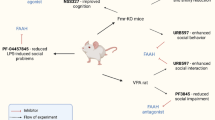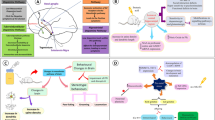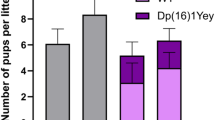Abstract
Rationale
Autism spectrum disorder (ASD) is a neurodevelopmental disorder characterized by deficits in social communication and cognitive behaviors. Histamine H3 receptor (H3R) antagonists are considered as therapeutic factors for treating cognitive impairments.
Objectives
The aim of the present study was to evaluate the effects of the H3R antagonist, ciproxifan (CPX), on cognition impairment especially, spatial learning memory, and synaptic plasticity in the CA1 region of the hippocampus in autistic rats.
Methods
Pregnant rats were injected with either valproic acid (VPA) (600 mg/kg, i.p.) or saline on an embryonic day 12.5 (E12.5). The effects of the H3R antagonist, ciproxifan (CPX) (1, 3 mg/kg, i.p.), were investigated on learning and memory in VPA-exposed rat pups and saline-exposed rat pups using Morris water maze (MWM) and social interaction tasks. The H2R antagonist, famotidine (FAM) (10, 20, 40 mg/kg, i.p.), was used to determine whether brain histaminergic neurotransmission exerted its procognitive effects through the H2R. In addition, synaptic reinforcement was evaluated by in vivo field potential recording.
Results
The results showed that VPA-exposed rat pups had significantly lower sociability and social memory performance compared to the saline rats. VPA-exposed rat pups exhibited learning and memory impairments in the MWM task. In addition, VPA caused suppression of long-term potentiation (LTP) in the CA1 area of the hippocampus. Our results demonstrated that CPX 3 mg/kg improved VPA-induced cognitive impairments and FAM 20 mg/kg attenuated cognitive behaviors as well as electrophysiological properties.
Conclusions
CPX 3 mg/kg improved VPA-induced impairments of LTP as well as learning and memory deficits through H2R.












Similar content being viewed by others
References
Amaral DG (2002) The primate amygdala and the neurobiology of social behavior: implications for understanding social anxiety. Biol Psychiatry 51(1):11–17
Bardgett M, Davis N, Griffith M (2009) Ciproxifan, an H~ 3~ receptor antagonist, improves learning and memory in the APP mouse model of Alzheimer’s disease. Nature Precedings:1–1
Bardgett ME et al (2011) Ciproxifan, an H3 receptor antagonist, alleviates hyperactivity and cognitive deficits in the APPTg2576 mouse model of Alzheimer’s disease. Neurobiol Learn Mem 95(1):64–72
Barendse EM et al (2013) Working memory deficits in high-functioning adolescents with autism spectrum disorders: neuropsychological and neuroimaging correlates. J Neurodev Disord 5(1):1–11
Baron-Cohen S et al (1999) Social intelligence in the normal and autistic brain: an fMRI study. Eur J Neurosci 11(6):1891–1898
Baronio D et al (2015) Effects of an H3R antagonist on the animal model of autism induced by prenatal exposure to valproic acid. PLoS One 10(1):e0116363
Bekkers JM (1993) Enhancement by histamine of NMDA-mediated synaptic transmission in the hippocampus. Science 261(5117):104–106
Benetti F et al (2015) Histamine in the basolateral amygdala promotes inhibitory avoidance learning independently of hippocampus. Proc Natl Acad Sci 112(19):E2536–E2542
Bickart KC et al (2011) Amygdala volume and social network size in humans. Nat Neurosci 14(2):163–164
Bliss TV, Collingridge GL (1993) A synaptic model of memory: long-term potentiation in the hippocampus. Nature 361(6407):31–39
Boustani M et al (2007) The association between cognition and histamine-2 receptor antagonists in African Americans. J Am Geriatr Soc 55(8):1248–1253
Brown R et al (1995) Histaminergic modulation of synaptic plasticity in area CA1 of rat hippocampal slices. Neuropharmacology 34(2):181–190
Brown R, Stevens DR, Haas HL (2001) The physiology of brain histamine. Prog Neurobiol 63:637–672
Buescher AVS et al (2014) Costs of autism spectrum disorders in the United Kingdom and the United States. JAMA Pediatr 168(8):721–728
Campolongo M et al (2018) Sociability deficits after prenatal exposure to valproic acid are rescued by early social enrichment. Mol Autism 9(1):1–17
Chauveau F et al (2014) Ciproxifan improves working memory through increased prefrontal cortex neural activity in sleep-restricted mice. Neuropharmacology 85:349–356
Chauveau F et al (2019) Procognitive impact of ciproxifan (a histaminergic H3 receptor antagonist) on contextual memory retrieval after acute stress. CNS Neurosci Ther 25(8):832–841
Chiarotti F, Venerosi A (2020) Epidemiology of autism spectrum disorders: a review of worldwide prevalence estimates since 2014. Brain Sci 10(5):274
Collingridge GL et al (2010) Long-term depression in the CNS. Nat Rev Neurosci 11(7):459–473
Cooper RA, Simons JS (2019) Exploring the neurocognitive basis of episodic recollection in autism. Psychon Bull Rev 26(1):163–181
De Rubeis S et al (2014) Synaptic, transcriptional and chromatin genes disrupted in autism. Nature 515(7526):209–215
Decety J et al (2013) An fMRI study of affective perspective taking in individuals with psychopathy: imagining another in pain does not evoke empathy. Front Hum Neurosci 7:489
Eissa N et al (2018a) The histamine H3R antagonist DL77 attenuates autistic behaviors in a prenatal valproic acid-induced mouse model of autism. Sci Rep 8(1):1–15
Eissa N et al (2018b) Current enlightenment about etiology and pharmacological treatment of autism spectrum disorder. Front Neurosci 12:304
Eissa N et al (2018c) The histamine H3 receptor antagonist DL77 ameliorates MK801-induced memory deficits in rats. Front Neurosci 12:42
Eissa N et al (2020) Simultaneous blockade of histamine H3 receptors and inhibition of acetylcholine esterase alleviate autistic-like behaviors in BTBR T+ tf/J mouse model of autism. Biomolecules 10(9):1251
Elder, J.H., et al., Clinical impact of early diagnosis of autism on the prognosis and parent–child relationships. Psychology research and behavior management, 2017.
Ferreira R et al (2012) Histamine modulates microglia function. J Neuroinflammation 9(1):1–16
Fiorenza NG et al (2012) Modulation of the extinction of two different fear-motivated tasks in three distinct brain areas. Behav Brain Res 232(1):210–216
Fombonne E (2020) Epidemiological controversies in autism. Swiss Archives of Neurology. Psychiatr Psychother 171(01)
Gao J et al (2016) Neuroprotective effects of docosahexaenoic acid on hippocampal cell death and learning and memory impairments in a valproic acid-induced rat autism model. Int J Dev Neurosci 49:67–78
Grover LM, Teyler TJ (1990) Two components of long-term potentiation induced by different patterns of afferent activation. Nature 347(6292):477–479
Haas HL, Sergeeva OA, Selbach O (2008) Histamine in the nervous system. Physiol Rev
Habib A et al (2019) A meta-analysis of working memory in individuals with autism spectrum disorders. PLoS One 14(4):e0216198
Hansen SN, Schendel DE, Parner ET (2015) Explaining the increase in the prevalence of autism spectrum disorders: the proportion attributable to changes in reporting practices. JAMA Pediatr 169(1):56–62
Hanson E et al (2007) Use of complementary and alternative medicine among children diagnosed with autism spectrum disorder. J Autism Dev Disord 37(4):628–636
Hara Y et al (2016) Improvement by methylphenidate and atomoxetine of social interaction deficits and recognition memory impairment in a mouse model of valproic acid-induced autism. Autism Res 9(9):926–939
Hara Y et al (2017) Oxytocin attenuates deficits in social interaction but not recognition memory in a prenatal valproic acid-induced mouse model of autism. Horm Behav 96:130–136
Hernandez-Lallement J et al (2016) Basolateral amygdala lesions abolish mutual reward preferences in rats. Neurobiol Learn Mem 127:1–9
Hertz-Picciotto I, Schmidt RJ, Krakowiak P (2018) Understanding environmental contributions to autism: causal concepts and the state of science. Autism Res 11(4):554–586
Hu W, Chen Z (2017) The roles of histamine and its receptor ligands in central nervous system disorders: An update. Pharmacol Ther 175:116–132
Huang Y-W et al (2003) Facilitating effect of histamine on spatial memory deficits induced by dizocilpine as evaluated by 8-arm radial maze in SD rats. Acta Pharmacol Sin 24(12):1270–1276
Idring S et al (2015) Changes in prevalence of autism spectrum disorders in 2001–2011: findings from the Stockholm youth cohort. J Autism Dev Disord 45(6):1766–1773
Joushi S et al (2021) Intranasal oxytocin administration facilitates the induction of long-term potentiation and promotes cognitive performance of maternally separated rats. Psychoneuroendocrinology 123:105044
Kataoka S et al (2013) Autism-like behaviours with transient histone hyperacetylation in mice treated prenatally with valproic acid. Int J Neuropsychopharmacol 16(1):91–103
Katayama T et al (2009) Phencyclidine affects firing activity of basolateral amygdala neurons related to social behavior in rats. Neuroscience 159(1):335–343
Kiehl KA et al (2001) Limbic abnormalities in affective processing by criminal psychopaths as revealed by functional magnetic resonance imaging. Biol Psychiatry 50(9):677–684
Komater VA et al (2005) Effects of histamine H3 receptor antagonists in two models of spatial learning. Behav Brain Res 159(2):295–300
Kumar A et al (2019) Chronic histamine 3 receptor antagonism alleviates depression like conditions in mice via modulation of brain-derived neurotrophic factor and hypothalamus-pituitary adrenal axis. Psychoneuroendocrinology 101:128–137
Lee S-M et al (2016) Music application alleviates short-term memory impairments through increasing cell proliferation in the hippocampus of valproic acid-induced autistic rat pups. J Exerc Rehabil 12(3):148
Leung LS, Shen B (1999) N-methyl-D-aspartate receptor antagonists are less effective in blocking long-term potentiation at apical than basal dendrites in hippocampal CA1 of awake rats. Hippocampus 9(6):617–630
Lind SE et al (2013) Spatial navigation impairments among intellectually high-functioning adults with autism spectrum disorder: exploring relations with theory of mind, episodic memory, and episodic future thinking. J Abnorm Psychol 122(4):1189
Llaneza DC et al (2010) Communication, interventions, and scientific advances in autism: a commentary. Physiol Behav 100(3):268–276
Loureiro M et al (2012) The ventral hippocampus is necessary for expressing a spatial memory. Brain Struct Funct 217(1):93–106
Luo T et al (2017) Histamine H3 receptor antagonist prevents memory deficits and synaptic plasticity disruption following isoflurane exposure. CNS Neurosci Ther 23(4):301–309
Martin HGS, Manzoni O (2014) Late onset deficits in synaptic plasticity in the valproic acid rat model of autism. Front Cell Neurosci 8:23
Meador KJ et al (2009) Cognitive function at 3 years of age after fetal exposure to antiepileptic drugs. N Engl J Med 360(16):1597–1605
Melancia F et al (2018) Sex-specific autistic endophenotypes induced by prenatal exposure to valproic acid involve anandamide signalling. Br J Pharmacol 175(18):3699–3712
Miguez A et al (2015) Fingolimod (FTY720) enhances hippocampal synaptic plasticity and memory in Huntington’s disease by preventing p75NTR up-regulation and astrocyte-mediated inflammation. Hum Mol Genet 24(17):4958–4970
Mojtahedin A, Tamaddonfard E, Zanbouri A (2008) Effects of mepyramine and famotidine on the physostigmine-induced antinociception in the formalin test in rats. Pak J Biol Sci 11(22):2573
Morgan JT et al (2014) Stereological study of amygdala glial populations in adolescents and adults with autism spectrum disorder. PLoS One 9(10):e110356
Muller D et al (2002) LTP, memory and structural plasticity. Curr Mol Med 2(7):605–611
Nicolini C, Fahnestock M (2018) The valproic acid-induced rodent model of autism. Exp Neurol 299:217–227
Panula P, Nuutinen S (2013) The histaminergic network in the brain: basic organization and role in disease. Nat Rev Neurosci 14(7):472–487
Radeloff D et al (2014) Structural alterations of the social brain: a comparison between schizophrenia and autism. PLoS One 9(9):e106539
Rajizadeh MA et al (2019) Does caffeine therapy improve cognitive impairments in valproic acid rat model of autism? Toxin Rev:1–11
Rajizadeh MA et al (2020) Voluntary exercise modulates learning & memory and synaptic plasticity impairments in sleep deprived female rats. Brain Res 1729:146598
Rani B et al (2021) Short- and long-term social recognition memory are differentially modulated by neuronal histamine. Biomolecules 11(4):555
Rehman NU et al (2020) Effect of 4-Fluoro-N-(4-sulfamoylbenzyl) Benzene Sulfonamide on cognitive deficits and hippocampal plasticity during nicotine withdrawal in rats. Biomed Pharmacother 131:110783
Rocha L et al (2015) GABAergic alterations in neocortex of patients with pharmacoresistant temporal lobe epilepsy can explain the comorbidity of anxiety and depression: the potential impact of clinical factors. Front Cell Neurosci 8:442
Sadek B, Stark H (2016) Cherry-picked ligands at histamine receptor subtypes. Neuropharmacology 106:56–73
Sadek B et al (2016a) Histamine H3 receptor as a potential target for cognitive symptoms in neuropsychiatric diseases. Behav Brain Res 312:415–430
Sadek B et al (2016b) Anticonvulsant and procognitive properties of the non-imidazole histamine H3 receptor antagonist DL77 in male adult rats. Neuropharmacology 106:46–55
Schulkin J (2007) Autism and the amygdala: an endocrine hypothesis. Brain Cogn 65(1):87–99
Seese RR et al (2014) Long-term memory deficits are associated with elevated synaptic ERK1/2 activation and reversed by mGluR5 antagonism in an animal model of autism. Neuropsychopharmacology 39(7):1664–1673
Servadio M et al (2016) Targeting anandamide metabolism rescues core and associated autistic-like symptoms in rats prenatally exposed to valproic acid. Transl Psychiatry 6(9):e902–e902
Servadio M et al (2018) Impaired repair of DNA damage is associated with autistic-like traits in rats prenatally exposed to valproic acid. Eur Neuropsychopharmacol 28(1):85–96
Slugg PH, Haug MT, Pippenger CE (1992) Ranitidine pharmacokinetics and adverse central nervous system reactions. Arch Intern Med 152(11):2325–2329
Srinivasan P (2009) A review of dietary interventions in autism. Ann Clin Psychiatry 21(4):237–247
Steele SD et al (2007) Spatial working memory deficits in autism. J Autism Dev Disord 37(4):605–612
Taheri F et al (2018) Lavandula angustifolia and combination of Lavandula angustifolia and Zataria multiflora administration attenuates prenatal lead-exposed induced learning and memory impairments in male rats. Toxin Rev 37(3):231–242
Takuma K et al (2014) Chronic treatment with valproic acid or sodium butyrate attenuates novel object recognition deficits and hippocampal dendritic spine loss in a mouse model of autism. Pharmacol Biochem Behav 126:43–49
Tian Y et al (2014) Melatonin reverses the decreases in hippocampal protein serine/threonine kinases observed in an animal model of autism. J Pineal Res 56(1):1–11
Ting JT, Peça J, Feng G (2012) Functional consequences of mutations in postsynaptic scaffolding proteins and relevance to psychiatric disorders. Annu Rev Neurosci 35:49–71
de Visser L et al (2011) Rodent versions of the Iowa gambling task: opportunities and challenges for the understanding of decision-making. Front Neurosci 5:109
Wang X et al (2020) Transcutaneous electrical acupoint stimulation in early life changes synaptic plasticity and improves symptoms in a valproic acid-induced rat model of autism. Neural Plasticity 2020
Witkin J, Nelson D (2004) Selective histamine H3 receptor antagonists for treatment of cognitive deficiencies and other disorders of the central nervous system. Pharmacol Ther 103(1):1–20
Wright C et al (2017) Altered expression of histamine signaling genes in autism spectrum disorder. Transl Psychiatry 7(5):e1126–e1126
Wu P, Jiang L, Chen H (2010) Sodium valproate at the therapeutic concentration inhibits the induction but not the maintenance phase of long-term potentiation in rat hippocampal CA1 area. Biochem Biophys Res Commun 391(1):582–586
Wu H et al (2018) Modulation of sphingosine 1-phosphate (S1P) attenuates spatial learning and memory impairments in the valproic acid rat model of autism. Psychopharmacology 235(3):873–886
Xu LS et al (2009) Ameliorative effects of histamine on spatial memory deficits induced by scopolamine infusion into bilateral dorsal or ventral hippocampus as evaluated by the radial arm maze task. Clin Exp Pharmacol Physiol 36(8):816–821
Yang Y et al (2009) Localization of deformations within the amygdala in individuals with psychopathy. Arch Gen Psychiatry 66(9):986–994
Yang E-J et al (2016) Early behavioral abnormalities and perinatal alterations of PTEN/AKT pathway in valproic acid autism model mice. PLoS One 11(4):e0153298
Zhang M-M et al (2003) Effects of sodium valproate on synaptic plasticity in the CA1 region of rat hippocampus. Food Chem Toxicol 41(11):1617–1623
Zlomuzica A et al (2016) Neuronal histamine and cognitive symptoms in Alzheimer’s disease. Neuropharmacology 106:135–145
Zoghbi HY, Bear MF (2012) Synaptic dysfunction in neurodevelopmental disorders associated with autism and intellectual disabilities. Cold Spring Harb Perspect Biol 4(3):a009886
Acknowledgements
This study was supported by the Kerman Neuroscience Research Center, Kerman University of Medical Sciences, Kerman, Iran.
Author information
Authors and Affiliations
Corresponding authors
Ethics declarations
Competing interests
The authors declare no competing interests.
Additional information
Publisher’s note
Springer Nature remains neutral with regard to jurisdictional claims in published maps and institutional affiliations.
Rights and permissions
About this article
Cite this article
Taheri, F., Esmaeilpour, K., Sepehri, G. et al. Histamine H3 receptor antagonist, ciproxifan, alleviates cognition and synaptic plasticity alterations in a valproic acid-induced animal model of autism. Psychopharmacology 239, 2673–2693 (2022). https://doi.org/10.1007/s00213-022-06155-z
Received:
Accepted:
Published:
Issue Date:
DOI: https://doi.org/10.1007/s00213-022-06155-z




